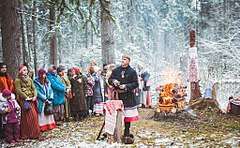List of Neopagan movements
Modern paganism, also known as "contemporary" or "neopagan", encompasses a wide range of religious groups and individuals. These may include old occult groups, those that follow a New Age approach, those that try to reconstruct old ethnic religions, and followers of the pagan religion of Wicca.

Early movements
.png)
Pre-World War II neopagan or proto-neopagan groups, growing out of occultism and/or Romanticism (Mediterranean revival, Viking revival, Celtic revival, etc.).
- Neo-druidism
- Ancient Order of Druids (1781)
- The Druid Order (1909)
- Hermetic Order of the Golden Dawn (1888)
- Crowleyan Thelema (1904)
- Germanic neopaganism/Armanism
- Germanische Glaubens-Gemeinschaft (1907)
- Guido von List Society (1908)
- Church of the Universal Bond (1912)
- Adonism (1925)
Witchcraft
Wicca originated in 1940s Britain and became the mainstream of Neopaganism in the United States in the 1970s. There are two core traditions of Wicca which originated in Britain, Gardnerian and Alexandrian, which are sometimes referred to as British Traditional Wicca. From these two arose several other variant traditions. Wicca has also inspired a great number of other witchcraft traditions in Britain, Europe and the United States, most of which base their beliefs and practices on Wicca. Many movements are influenced by the Movement of the Goddess, and New Age and feminist worldviews.
Wicca
.png)
- British Traditional Wicca
- Gardnerian Wicca (1954)
- Alexandrian Wicca (1967)
- Central Valley Wicca (1969)
- Algard Wicca (1972)
- Chthonioi Alexandrian Wicca (1974)
- Blue Star Wicca (1975)
- Eclectic Wicca and Inclusive Wicca
- Celtic Wicca
- Saxon Wicca
- Dianic Wicca
- McFarland Dianic Wicca
- Faery Wicca
- Georgian Wicca
- Odyssean Wicca
- Wiccan church
- New Reformed Orthodox Order of the Golden Dawn (1968)
- Church and School of Wicca (1968)
- Circle Sanctuary (1974)
- Covenant of the Goddess (1975)
- Aquarian Tabernacle Church (1979)
- Rowan Tree Church (1979)
- Covenant of Unitarian Universalist Pagans (1985)
- Coven of the Far Flung Net (1998)
Other
- Stregheria (Italian tradition)
- Hedge Witchcraft
- Cochrane's Craft
- Children of Artemis
- Feri Tradition
- Reclaiming
New Age, eclectic or syncretic
Ethnic
- European Congress of Ethnic Religions
Germanic
Heathenism (also Heathenry, or Greater Heathenry), is a blanket term for the whole Germanic Neopagan movement. Various currents and denominations have arisen over the years within it.
- English-speaking world
- Heathenry in the United States
- Asatru Free Assembly (Stephen McNallen, 1974–1986)
- Ásatrú Alliance (1987)
- Ring of Troth (1987)
- Asatru Folk Assembly (1996)
- Odinism
- Odinist Fellowship (United States) (Else Christensen, 1971–2005)
- Odinic Rite (1973)
- Odinist Fellowship (United Kingdom) (1988)
- International Asatru-Odinic Alliance (1997–2002)
- Theodism (American tribalist movements)
- Heathenry in the United States
- Scandinavia
- Íslenska Ásatrúarfélagið (1972)
- Foreningen Forn Sed (1999)
- Samfälligheten för Nordisk Sed (1999)
- Swedish Asatru Assembly (1994)
- Åsatrufellesskapet Bifrost (1996)
- German-speaking Europe
- Eldaring (2000)
- Latin-speaking Europe
- Russian-speaking world/Russia
- Dark Ashtree community
- Скидбладнир
- Germanic mysticism (Armanism or Irminism/Irminenschaft/Ariosophy and Nordic racial paganism
- Heidnische Gemeinschaft (1985)
- Artgemeinschaft (1951)
- Deutsche Heidnische Front (1998)
- New Armanen-Orden
- Odin Brotherhood
- Wotansvolk
Celtic
- Celtic Reconstructionist Paganism (1980s)
- Neo-druidism or Neodruidry, or druidism or druidry
- Dynion Mwyn (1950s/60s)
- Reformed Druids of North America (1963)
- Order of Bards, Ovates and Druids (1964)
- Monastic Order of Avallon (1970)
- Ár nDraíocht Féin (1983)
Italic
- Italo-Roman neopaganism or Religio Romana
Baltic
- Dievturība (Latvian)
- Community of Latvian Dievturi (1926–early 1930s)
- Congregation of Latvian Dievturi (1927–1940)
- Latvian Church Dievturi (1971)
- Congregation of Latvian Dievturi (1990)
- Lithuanian neopaganism (Romuva)
Slavic

- Rodnovery (Native Faith) (1920–30s)
- Native Ukrainian National Faith, RUNVira (1964)
- Peterburgian Vedism
- Union of the Veneds (1986)
- Ynglism (1991)
- Native Polish Church (1995)
- Rodzima Wiara (1996)
- Union of Slavic Native Belief Communities (1997)
- Rodnover Confederation (2015)
- Commonwealth of Pagan Communities of Siberia–Siberian Veche (2015)
- Zadruga (1937)
- Ivanovism (1930s)
- Tezaurus Spiritual Union (Authentism) (1984)
- Russian national movement–Course of Truth and Unity (Conception of Social Security–Dead Water) (1985)
- Bazhovism (1992)
- Ringing Cedars' Anastasianism (1997)
Uralic
- Estonian neopaganism (Taaraism and Maausk)
- Maavalla Koda (1995)
- Finnish neopaganism
- Hungarian neopaganism
- Mari native religion
- Mordvin native religion
- Udmurt Vos
Caucasian
Other European
.png)
- Armenian Native Faith (Hetanism)
- Assianism (Ossetian Native Faith)
- Vainakh religion
- Hellenism (revival of Ancient Greek religion)
- Zalmoxianism
Turko-Mongolic

- Aar Aiyy Faith (Yakut: Аар Айыы итэҔэлэ) (1996)[1]
- Aiyy Faith (Yakut: Айыы итэҔэлэ), former Kut-Siur (1990)[1]
- Aiyy Tangara Faith (Yakut: Айыы Таҥара итэҔэлэ) (2019)[2]
- Burkhanism/Ak Jang (Altay: Ак Jаҥ) (1904)
- International Fund of Tengri Research (Russian: Международный Фонд Исследования Тенгри) (2011)[1]
- Mongolian shamanism/Tengerism (Mongolian: Бөө мөргөл/Тэнгэризм)
- Tengir Ordo (Kyrgyz: Теңир Ордо) (2005)
- Vattisen Yaly (Chuvash: Ваттисен йăли)
- Chuvash National Congress (Chuvash: Чăваш наци конгресĕ) (1989–1992)
- Chuvash Traditional Faith Organization "Tura" (Russian: Организация традиционной веры чувашей "Тура") (1995)[1]
Canarian
Semitic
Kemetic
- Kemetism
- Ausar Auset
- Kemetic Orthodoxy
American
- Ausar Auset Society (1973)
- Mexicayotl
- Native American Church (late 19th c.)
References
- Popov, Igor (2016). "Тюрко-монгольские религии (тенгрианство)" [Turko-Mongolic Religions (Tengrism)]. Справочник всех религиозных течений и объединений в России [The Reference Book on All Religious Branches and Communities in Russia] (in Russian). Retrieved 2019-11-23.
- "First Tengrian religious organization registered" (in Russian). International Fund of Tengri Research. 2019-04-22. Retrieved 2019-11-23.
- Balogh, Matyas (2010). "Contemporary shamanisms in Mongolia". Asian Ethnicity. 11 (2): 229–38. doi:10.1080/14631361003779489.
- Schlehe, Judith (2004). "Shamanism in Mongolia and in New Age Movements". In Rasuly-Paleczek, Gabriele (ed.). Central Asia on Display: Proceedings of the VIIth Conference of the European Society for Central Asian Studies. 1. Vienna: Lit Verlag. pp. 283–96. ISBN 3-8258-8309-4.